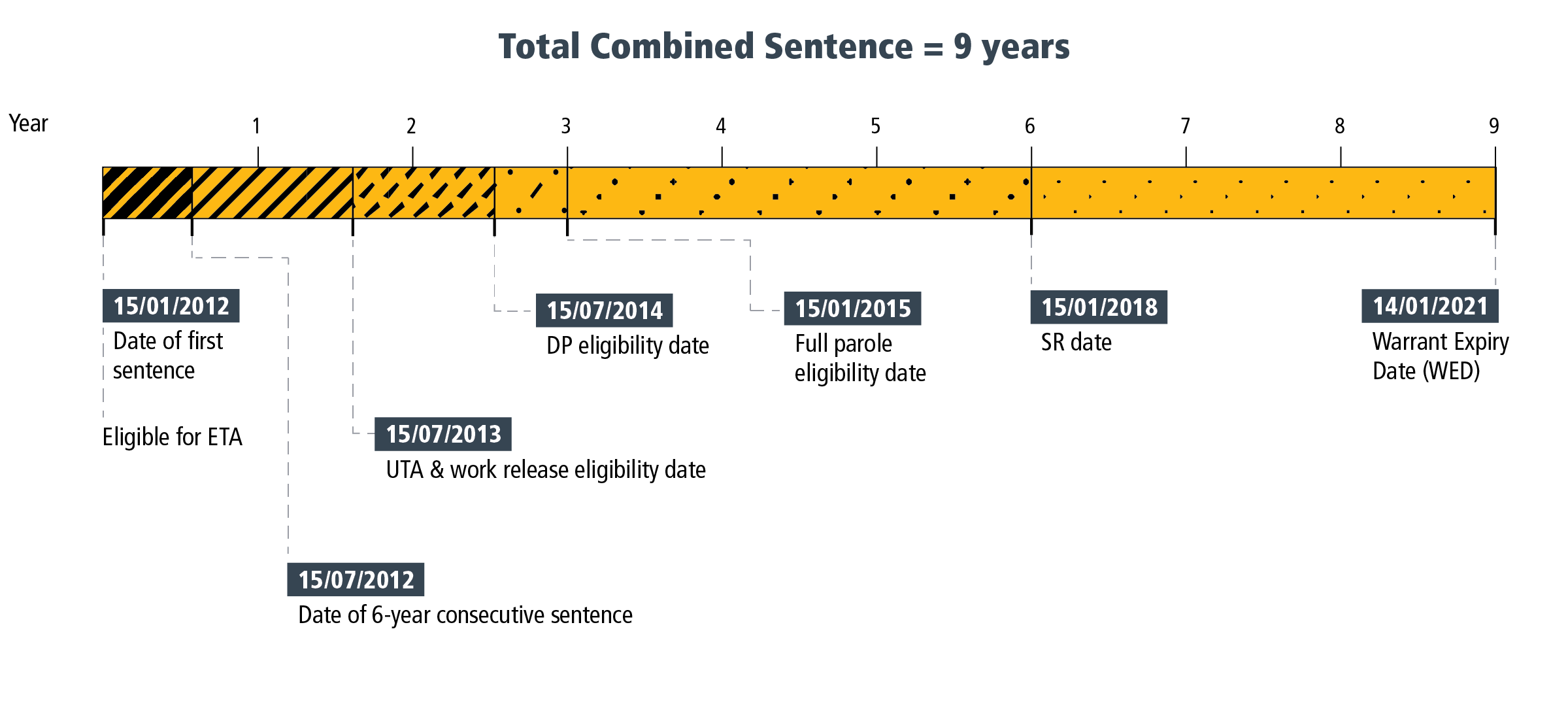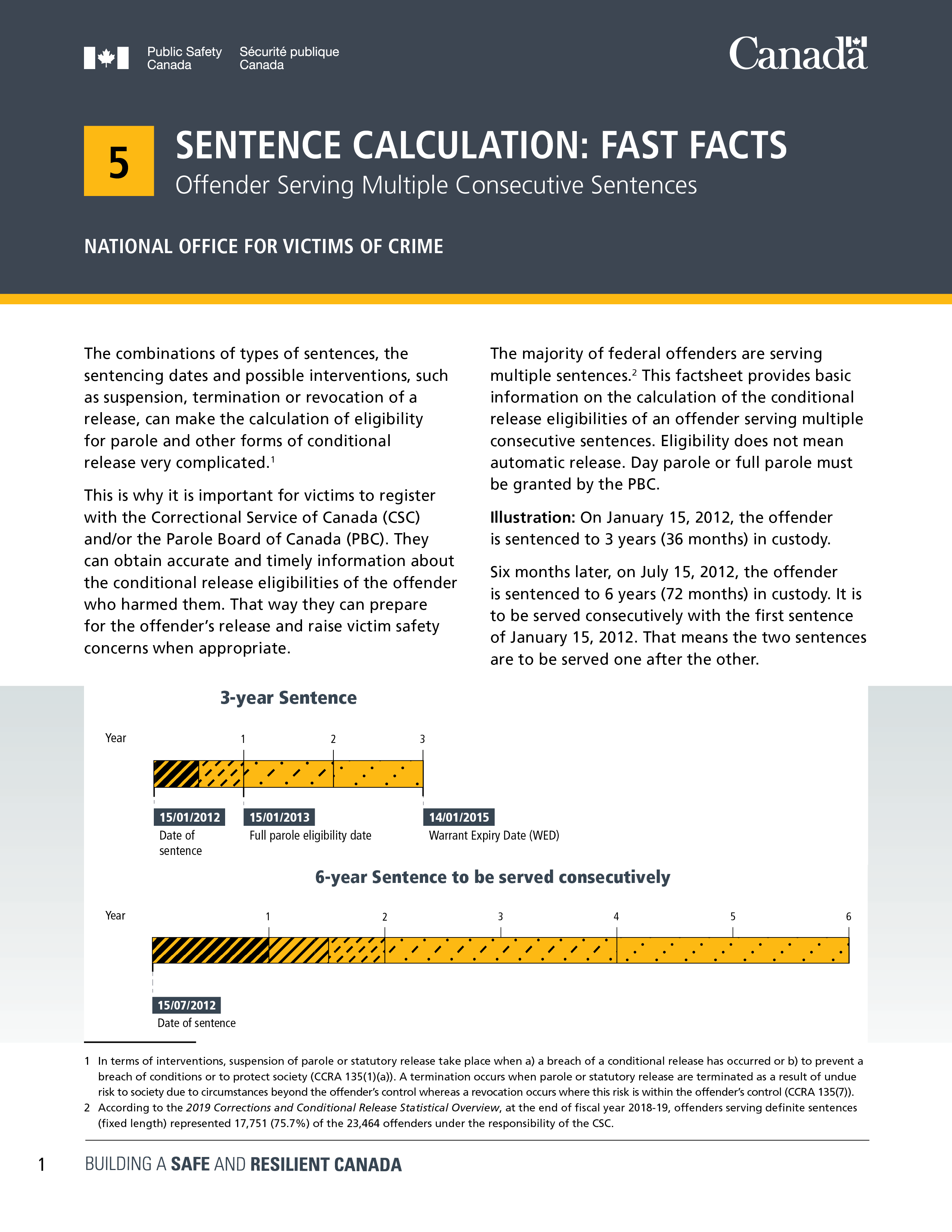Sentence Calculation: Fast Facts: Offenders Serving Multiple Consecutive Sentences
National Office for Victims of Crime
The combinations of types of sentences, the sentencing dates and possible interventions, such as suspension, termination or revocation of a release, can make the calculation of eligibility for parole and other forms of conditional release very complicated.Footnote 1
This is why it is important for victims to register with the Correctional Service of Canada (CSC) and/or the Parole Board of Canada (PBC). They can obtain accurate and timely information about the conditional release eligibilities of the offender who harmed them. That way they can prepare for the offender’s release and raise victim safety concerns when appropriate.
The majority of federal offenders are serving multiple sentences.Footnote 2 This factsheet provides basic information on the calculation of the conditional release eligibilities of an offender serving multiple consecutive sentences. Eligibility does not mean automatic release. Day parole or full parole must be granted by the PBC.
Illustration: On January 15, 2012, the offender is sentenced to 3 years (36 months) in custody.
Six months later, on July 15, 2012, the offender is sentenced to 6 years (72 months) in custody. It is to be served consecutively with the first sentence of January 15, 2012. That means the two sentences are to be served one after the other.

Image description
This timeline illustrates a six year consecutive sentence. The sentence begins on July 15th 2012.
- This timeline illustrates a three year sentence, and the eligibility date for full parole.
- The sentence begins on January 15th, 2012, and lasts three years until the warrant expiry date on January 14th, 2015.
- The eligibility date for full parole is January 15th, 2013.
Combining Sentences
Under subsection 139(1) of the Corrections and Conditional Release Act (CCRA), the first and second sentences are combined into one sentence. The sentences are to be served consecutively. That means that the sentences are added together. In this case, the total length of the combined sentence is (3 years plus 6 years) 9 years.
The start date of the sentence remains the same (January 15, 2012). The warrant expiry date (WED) of the combined sentence is January 14, 2021.
Full Parole Eligibility
Under subsection 120.1(2) of the CCRA, in order to become eligible for full parole, the offender must serve, from the date the new sentence is imposed:
- the remaining parole ineligibility period of the first sentence; plus
- the period of ineligibility of the second sentence OR if there are other sentences that are consecutive to the first sentence and to each other, the total of the ineligibility periods of all the additional sentences.
In this case,
- 6 months is the parole ineligibility period remaining on the first 3-year sentence. In other words, because the second 6-year sentence was imposed on July 15, 2012, there remains 6 months of parole ineligibility (from July 15, 2012 to January 14, 2013) on the first 3-year sentence.
- 2 years is the parole ineligibility period for the new sentence (1/3 of 6 years = 2 years).
The new parole ineligibility period is therefore 2 years and 6 months from July 15, 2012, the date the new 6-year consecutive sentence was imposed. The parole eligibility date is now January 15, 2015. Eligibility does not mean automatic release. Full parole must be granted by the PBC.

Image description
- This timeline illustrates a total combined sentence of nine years, and the eligibility date for full parole.
- The sentence begins on January 15th, 2012 and lasts nine years until warrant expiry on January 14th, 2021.
- The six year consecutive sentence was imposed on July 15th, 2012.
- The eligibility date for full parole is January 15th, 2015.
Eligibility for Temporary Absences, Work Release, Day Parole And Statutory Release
Escorted temporary absence (ETA): Under subsection 17 of the CCRA, an offender serving a fixed sentence may be granted an ETA at any time. That is the case in this example.
Unescorted temporary absence (UTA): Under paragraph 115(1)(c) of the CCRA, an offender serving a fixed sentence is eligible for an UTA after serving 6 months or ½ of the offender’s full parole eligibility date, whichever date comes later. In this case, the later UTA eligibility date is July 15, 2013. That means 18 months after the start (January 15, 2012) of the combined sentence.
Work release: Under subsection 18(2) of the CCRA, an offender is eligible for work release on the same date they are eligible for an UTA. In this case, that date is July 15, 2013.
Day Parole (DP): Under paragraph 119(1)(c) of the CCRA, an offender serving a fixed sentence is eligible for DP after serving 6 months or 6 months before full parole eligibility, whichever date comes later. In this case, the later DP eligibility date is July 15, 2014. It is 2 years and 6 months after the start (January 15, 2012) of the combined sentence.
Statutory Release (SR): Under subsection 127(3) of the CCRA, an offender is entitled to SR after serving 2/3 of the 9-year sentence from the start date (January 15, 2012) of the combined sentence. Under subsection 130(3) of the CCRA, the PBC, after a review, can order the detention of an offender under certain circumstances rather than release them on SR. In this case, the SR date is January 15, 2018.
N.B. These rules establish the earliest possible eligibility date for ETAs, UTAs, work release, DP, full parole and statutory release. Eligibility does not mean automatic release. Only SR is an entitlement that the PBC can prohibit with a detention order. These conditional releases must be granted by the appropriate authority.

Image description
- This timeline illustrates a total combined sentence of nine years, and the eligibility dates for an escorted temporary absence, an unescorted temporary absence, work release, day parole, full parole, the statutory release date, and the warrant expiry date.
- The first sentence began on January 15th, 2012 and lasted nine years until the warrant expiry date on January 14th, 2021.
- The eligibility date for an escorted temporary absence (ETA) is at any time during the sentence beginning on January 15th, 2012.
- The six year consecutive sentence began on July 15th, 2012.
- The eligibility date for an unescorted temporary absence (UTA) and work release is July 15th, 2013.
- The eligibility date for day parole is July 15th, 2014.
- The eligibility date for full parole is January 15th, 2015.
- The statutory release date is January 15th, 2018.
- Date modified:
